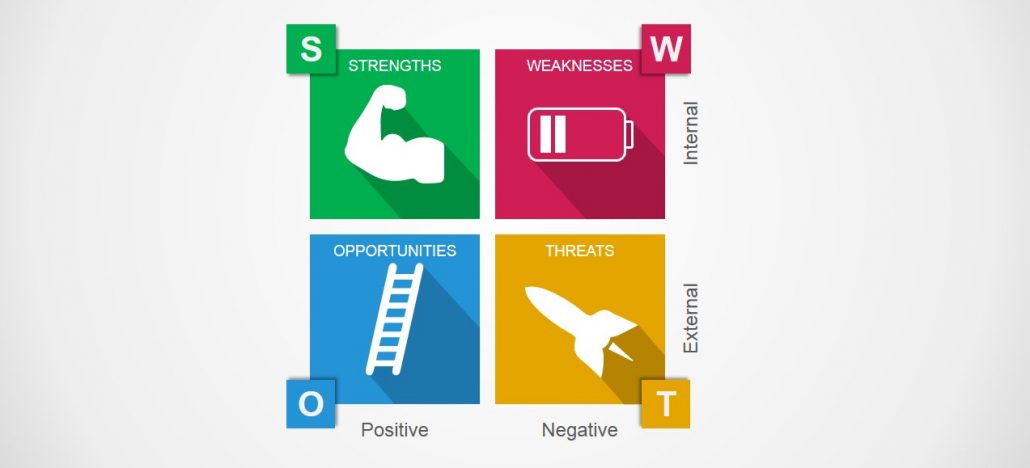SWOT analysis

SWOT analysis Identifying Strengths, Weaknesses, Opportunities and Threats
Overview
SWOT is an acronym for the Strengths, Weaknesses, Opportunities and Threats of a project or program. It is a strategic planning tool for identifying key factors that may influence specific projects or program. It is a collaborative tool that takes a whole-system approach.
How to use it
- Plan strategically for future goals and organizational development.
- Address well defined objectives and conduct internal assessments.
- Incorporate diverse perspectives by working collaboratively with multiple disciplines.
How to apply it
Start:
- Design four series of SWOT analysis questions to explore internal and external factors that may affect the objectives of a case study or challenge.
- Internal factors that generate strengths and weaknesses include human resources, finances, organizational structure and institutional culture.
- Common external factors that affect opportunities and threats may be economic, political, sociological or technological.
- Create a blank two-by-two table (see example) to capture the factors with a potential impact on the situation.
- Questions that guide the participants may be included in this table, or provided in a format such as flip-charts or hand-outs.
Time/Steps:
- Create small working groups of participants and instruct each to select a facilitator and a note taker.
- The facilitator must guide the discussion while remaining partial and supportive.
- The note taker will add key points into the matrix as the group agrees on them.
- The trainer should rotate among the groups to check that they are focused and to provide assistance.
- Use a bell, verbal announcement or other sound to indicate each quarter of the allocated time. This does not necessarily need to be adhered to, but will help participants manage time.
- Conclude the working session and have the small groups report back to the whole group.
- Lead a collaborative discussion that identifies priority areas for action.
- Record the key reflections and next steps in evaluating achievement of the learning objectives.
- Establish an appropriate follow-up to the activity. This may be an additional learning exercise, or informal communication in the future.
How to adapt it
- Create four working groups and tell each to address one aspect of the SWOT analysis: strengths, weaknesses, opportunities or threats.
- Provide a large rectangular piece of paper labelled with the element that they must analyse.
- After enough time has been allowed to discuss the subject (depending on its complexity), instruct each group to report back on the results of their work.
- Combine the notes of all four groups into a complete matrix by hanging them on the wall in a visible space.
- Lead a reflective conversation about the next steps and actions.
Case study
Title:
Strategic planning with the SWOT method
Activity:
Union retreat, Geneva
Contact:
N.Serriere@itcilo.org (IPSD), T.Wambeke@itcilo.org (DELTA)
Description:
Union representatives convened to develop an action plan for activities in the coming year. The participants were divided into groups of four, and each group was assigned one of the four areas to analyze. After a participatory working session, the groups reconvened to discuss all four areas. They identified 3 priority areas for action, then split again to form 3 working groups, one for each priority. These groups planned measures and means with which to implement the changes. The participants returned for one final whole-group discussion to review the plan of action together. The process was transformed into a guiding document for the union. The method used a limited time frame while remaining inclusive.
Tips
- Pay careful attention to the more obvious and subtle aspects of a scenario, as they can sometimes be overlooked in favour of grand or dramatic SWOT indicators.
- Ensure that the participants devote an appropriate amount of time to each of the four areas to create a balanced picture of the case or problem.
- Use of big signs, a sign for each of the indicators (S,W,O and T), can be useful to make the exercise more visual: http://www.amazon.com/Make-Space-Stage-Creative-Collaboration/dp/1118143728 (p.92-93)
Resources
- http://www.mindtools.com/pages/article/newTMC_05.htm
- Key approaches from a business perspective: http://forlearn.jrc.ec.europa.eu/guide/2_design/meth_swot-analysis.htm





